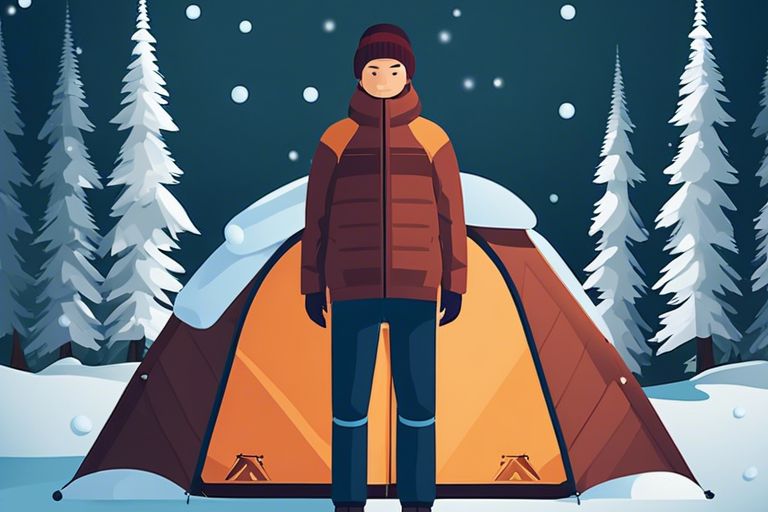Envisioning the frigid temperatures and harsh conditions of winter camping may seem daunting, but with the right clothing layers, you can stay warm and comfortable during your outdoor adventures. When it comes to winter camping, proper layering is essential to staying safe and enjoying your time in the great outdoors. In this guide, I will walk you through the art of layering clothing for winter camping, from base layers to outer shells, so you can stay warm, dry, and protected from the elements.
Layering your clothing properly is crucial for winter camping, as it allows you to regulate your body temperature and stay comfortable in changing weather conditions. With the right layers, you can stay warm and dry, avoiding the dangers of hypothermia and frostbite that can occur in extreme cold. By following these tips and techniques, you can make the most of your winter camping experience and enjoy the beauty of the snowy wilderness.
Key Takeaways:
- Understanding the Layering System: Familiarize yourself with the basics of layering clothing, including base layers, mid layers, and outer layers.
- Choose the Right Fabrics: Opt for moisture-wicking and insulating materials such as merino wool and synthetic fabrics for your base layers, insulating mid layers, and waterproof outer layers.
- Consider Your Activity Level: Adjust your layers based on your level of activity to prevent overheating or getting too cold during winter camping.
- Don’t Forget Accessories: Pack hats, gloves, scarves, and warm socks to protect your extremities from the cold.
- Be Prepared for Weather Changes: Have additional layers available in case the weather takes a turn for the worse, and always carry a waterproof outer layer to shield yourself from rain or snow.
Factors to Consider When Layering for Winter Camping
Some factors to consider when layering for winter camping include
- temperature and weather conditions
- activity level and personal metabolism
- material and fabric types
. The proper layering system is essential in order to stay warm and dry in cold, winter conditions while engaging in outdoor activities.
Temperature and Weather Conditions
When planning for winter camping, it is crucial to consider the temperature and weather conditions you will encounter. Your layering system should be adaptable and adjustable based on the forecast. Below is a guide to layering according to various temperature and weather conditions:
| Cold and Dry Conditions | Base layer + Insulating layer + Shell layer |
| Cold and Wet Conditions | Base layer + Insulating layer + Waterproof shell layer |
Activity Level and Personal Metabolism
Consider your activity level and personal metabolism when determining your layering system. Your level of physical activity and how quickly you generate and retain body heat will determine the number and types of layers you need. It’s important to avoid sweating excessively, as this can lead to rapid heat loss when you stop moving.
Material and Fabric Types
When choosing clothing for winter camping, the material and fabric types are crucial in creating an effective layering system. Consider the following when selecting your clothing:
- Base Layers: Moisture-wicking synthetic fabrics
- Insulating Layers: Down or synthetic materials
- Shell Layers: Waterproof and breathable fabrics
Assume that cotton is not your friend. It absorbs moisture and dries slowly, making it a poor choice for winter camping. Stick to synthetic or wool materials for optimal performance. Importantly, consider the fit and comfort of your clothing to ensure you can move freely while staying warm and protected from the elements.
Base Layers: Your Second Skin
Now that we’ve established the importance of layering for winter camping, let’s talk about the first layer of defense against the cold: your base layers. These are the foundation of your winter wardrobe and are essential for regulating your body temperature and keeping you dry and comfortable.
Characteristics of Effective Base Layers
When selecting base layers for winter camping, it’s important to look for garments that are moisture-wicking, breathable, and have insulating properties. Moisture-wicking fabrics such as merino wool or synthetic blends are designed to pull sweat away from your skin, keeping you dry and reducing the risk of hypothermia. Breathable materials allow for ventilation and help regulate your body temperature, while insulating fabrics provide warmth without adding bulk.
Tips for Choosing the Right Base Layer
When choosing the right base layer for winter camping, consider the activity level and the weather conditions you will be facing. For high-intensity activities, such as snowshoeing or cross-country skiing, opt for a lightweight base layer to prevent overheating. In colder conditions, a midweight or heavyweight base layer may be more suitable to provide extra warmth. Look for base layers with flatlock seams to minimize chafing and irritation against your skin. Remember to choose base layers that fit snugly but are not restrictive, as this will help to trap heat close to your body.
- Choose moisture-wicking fabrics such as merino wool or synthetic blends
- Consider the activity level and weather conditions when selecting the weight of the base layer
- Look for base layers with flatlock seams to minimize chafing
Perceiving how your base layer will perform in different winter camping scenarios will help you make the best choice for your outdoor adventures.
Insulation Layers: Retaining Body Heat
Lastly, let’s talk about the insulation layers. Insulation is designed to retain your body heat and keep you warm in cold weather. Choosing the right insulation layers is crucial for staying comfortable and safe during winter camping.
Types of Insulation Layers Explained
When it comes to insulation layers, there are two main types to consider: synthetic and down. Synthetic insulation is made from man-made materials and is typically more affordable, quick-drying, and insulates even when wet. On the other hand, down insulation is made from the soft under feathers of ducks or geese. It is highly compressible, lightweight, and provides excellent warmth. The decision between synthetic and down insulation ultimately comes down to your budget, the conditions you’ll be camping in, and your personal preference.
- Synthetic Insulation: Affordable, quick-drying, insulates when wet
- Down Insulation: Highly compressible, lightweight, excellent warmth
The type of insulation layer you choose will depend on the expected weather conditions and your specific camping needs. Ensure that you are well-informed about both types before making your decision. The amount and type of insulation you need will depend on the temperature, wind, and moisture levels you expect to encounter.
How to Select Insulation Based on Conditions
When choosing insulation layers, it’s important to consider the conditions you’ll be camping in. Temperature, wind, and humidity all play a role in determining the proper insulation for your needs. In extremely cold temperatures, you will need a thicker and more insulating layer to keep warm. If you expect high winds, look for a layer that provides wind resistance. In wet conditions, it is essential to have insulation that still performs when damp.
Make sure to thoroughly research the weather conditions of your camping location and plan accordingly. Having the appropriate insulation layers can be the difference between an enjoyable winter camping experience and a potentially dangerous one. You want to be warm and comfortable, but you also need to stay safe in harsh conditions.

Outer Layers: The Shield Against Elements
Now that you have your base and mid layers sorted, it’s time to talk about your outer layers. This is the last line of defense against the harsh winter elements. Your outer layers consist of your jacket, pants, gloves, and boots. It’s crucial to choose the right outer layers to keep yourself warm, dry, and protected during your winter camping trip. If you need further assistance with layering systems, you can browse through this Reddit thread where users discuss layering systems for autumn and winter camping.
Features of a Good Outer Layer
When choosing your outer layers, there are a few key features to look for. Firstly, insulation is critical. Your jacket and pants should be insulated to keep you warm in freezing temperatures. Look for materials such as down or synthetic insulation for maximum warmth. Additionally, your outer layers should be windproof and water-resistant to protect you from the biting cold and snow. Features such as adjustable hoods, cuffs, and hem are also beneficial as they allow you to seal out the cold and retain heat.
Balancing Breathability and Waterproofing
When it comes to your outer layers, finding the right balance between breathability and waterproofing is crucial. While you want your outer layers to keep you dry from the snow and rain, you also want them to allow moisture and sweat to escape. Look for outer layers with breathable membranes or venting systems to prevent overheating and sweat buildup. Remember, staying dry is just as important as staying warm in cold conditions.
Accessories and Extras
However, layering your clothing is just the beginning when it comes to staying warm during winter camping. You also need to pay attention to the accessories and extras that will help you stay comfortable and safe in the cold.
Essential Winter Camping Accessories
When winter camping, there are a few essential accessories that you shouldn’t leave home without. A good quality pair of gloves or mittens is essential for keeping your hands warm and protected from the elements. Look for options that are both warm and waterproof, as wet hands can lead to discomfort and even dangerous conditions such as frostbite. Additionally, a durable pair of waterproof and insulated boots is crucial for keeping your feet warm and dry. Invest in a pair that provides good traction to prevent slips and falls on icy terrain.
Layering for Hands, Feet, and Head
When it comes to layering for your extremities, focus on keeping them warm and protected from the wind and moisture. For your hands, consider wearing a thin, moisture-wicking liner glove underneath a thicker, insulated pair of gloves or mittens. Make sure your gloves have adjustable wrist straps to keep out snow and cold air. For your feet, layering with moisture-wicking socks underneath a thick pair of wool or synthetic-blend socks will help keep your feet warm and dry. Finally, for your head, a warm hat that covers your ears is essential, and a neck gaiter or balaclava can provide extra protection for your face and neck. Remember that covering exposed skin is crucial to preventing frostbite and hypothermia in cold temperatures.
Practical Layering Strategies
Despite the cold temperatures, winter camping can be an exciting and rewarding outdoor activity. With the right clothing and layering strategies, you can stay warm and comfortable while enjoying the beauty of the winter landscape. Here are practical layering strategies to help you stay warm and cozy during your winter camping adventures.
How-to Layer for Versatility and Comfort
When it comes to layering for winter camping, versatility and comfort are key. Start with a moisture-wicking base layer made of merino wool or synthetic materials. This will help to keep sweat away from your skin, preventing you from getting cold and clammy. For your mid-layer, opt for insulation that provides warmth without adding too much bulk. A down or synthetic-filled jacket can be a great option for this layer. Finally, your outer layer should be windproof and waterproof to protect you from the elements. Look for a breathable shell that allows sweat to escape while keeping you dry from rain or snow. This layering system will provide you with the versatility to adjust your clothing based on your activity level and the weather conditions.
Adjusting Layers During Activities
As you engage in various activities during winter camping, it’s important to understand how to adjust your layers to maintain comfort and safety. When you’re on the move, such as hiking or setting up camp, you may generate heat and sweat, causing your body temperature to rise. In these instances, removing a layer or partially unzipping your outer shell can help regulate your body temperature and prevent overheating. On the other hand, when you’re taking a break or the temperature drops, adding a layer or zipping up your jacket will help retain body heat. Be mindful of sweat accumulation and make sure to adjust your layers accordingly to prevent moisture build-up.
Maintenance and Care for Layered Clothing
Your winter camping clothing is an essential part of your gear, providing warmth and protection from the harsh elements. To ensure that your layered clothing continues to perform at its best, it’s crucial to give it proper maintenance and care. This involves cleaning and storing your winter layers, as well as repairing or replacing items as necessary.
Cleaning and Storing Your Winter Layers
After a winter camping trip, your clothing will likely be dirty and possibly damp from sweat or snow. It’s important to clean your layers properly to maintain their performance and longevity. Start by following the care instructions on the garment’s label, as different materials require different cleaning methods. Use a gentle detergent specifically designed for technical outdoor clothing, and avoid fabric softeners or bleach, as they can diminish the fabric’s performance. Once clean, make sure your layers are completely dry before storing them to prevent mold and mildew growth. Store your clothing in a cool, dry place away from direct sunlight to maintain their quality.
Repairing and Replacing Items as Necessary
Regularly inspect your winter camping clothing for any signs of damage, such as tears, worn-out seams, or broken zippers. It’s crucial to address these issues promptly to prevent further damage and maintain the effectiveness of your layers. Consider learning basic sewing skills to repair minor tears and seams yourself, or take your clothing to a professional for more complex repairs. Additionally, if any of your items become irreparably damaged or worn out, don’t hesitate to replace them. Remember that your winter camping clothing is an investment in your comfort and safety, so it’s important to keep it in the best possible condition.

To wrap up
When it comes to winter camping, layering your clothing properly is essential for staying warm and comfortable in the harsh conditions. By following the principles of wicking, insulating, and protecting against the elements, you can ensure that you are prepared for whatever Mother Nature throws at you. Remember to focus on moisture-wicking base layers, insulating mid layers, and protective outer layers, as well as investing in high-quality materials and adjusting your layers as needed throughout the day. With the right approach to layering, you can enjoy all the beauty and adventure that winter camping has to offer without sacrificing your warmth and comfort.
FAQ
Q: Why is it important to layer clothing for winter camping?
A: Layering clothing is crucial for winter camping as it provides insulation, moisture management, and versatility. It allows you to add or remove layers as needed to regulate your body temperature and stay comfortable throughout the day and night.
Q: What are the key principles of layering clothing for winter camping?
A: The key principles of layering for winter camping include using a base layer to manage moisture, adding an insulating layer for warmth, and finishing off with an outer shell to protect against wind and moisture. It’s important to choose fabrics that wick moisture, trap heat, and provide protection from the elements.
Q: What clothing items should I include in each layer for winter camping?
A: For the base layer, choose moisture-wicking and breathable fabrics such as merino wool or synthetic materials. The insulating layer should consist of materials like fleece, down, or synthetic fill that provide warmth without adding too much bulk. The outer shell should be waterproof and windproof to protect against snow, rain, and wind. Additionally, don’t forget to include accessories such as a hat, gloves, and warm socks to complete your layering system.


0 Comments